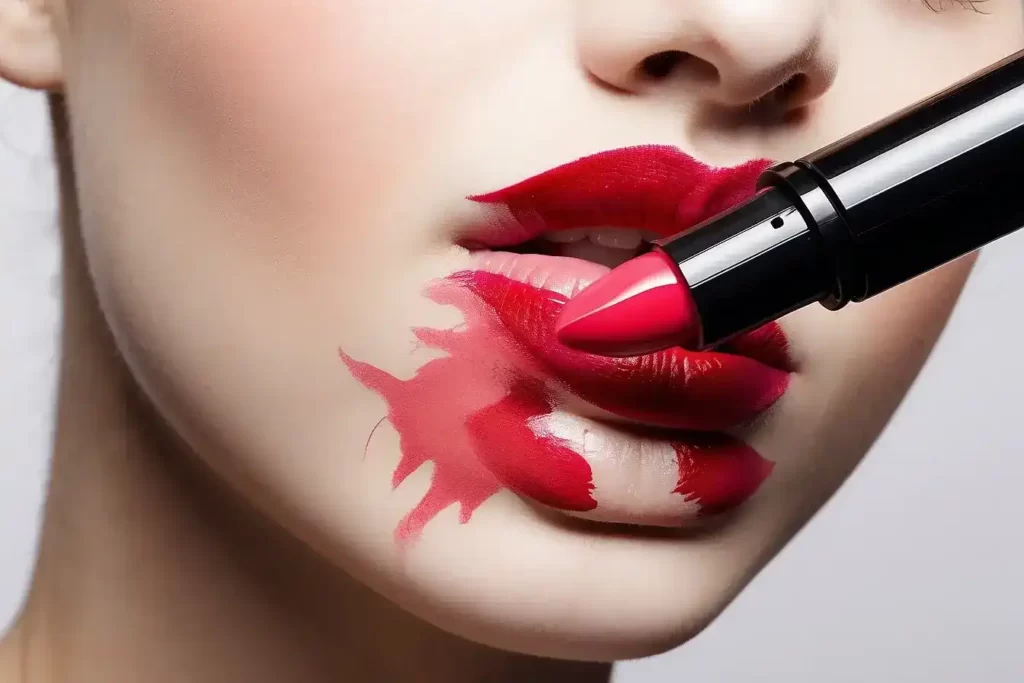Table of Contents
Toggle10 Effective Lipstick Stain Removal Techniques
lipstick stain removal on clothes can be a common and frustrating mishap, especially for those who love wearing makeup.Whether you accidentally brushed your favorite lipstick against your clothing or got caught in an unexpected smudge, dealing with these stains promptly and effectively is essential to preserve the appearance of your garments. The good news is that with the right techniques and quick action, removing lipstick stains from clothes is very much possible.
In this guide, we will explore 10 effective stain-removal techniques to help you tackle those pesky lipstick marks. Time is of the essence when dealing with stains, so the sooner you start the cleaning process, the better the chances of success.
Each technique offers a unique approach, and you may find that certain methods work better for specific fabric types or lipstick formulations. Remember that lipstick stains can be made up of oils, pigments, and waxes, which can make them more stubborn than other types of stains. Therefore, it’s crucial to choose the appropriate method for the fabric and lipstick in question. Most of the techniques outlined here use common household items, making them convenient and accessible for anyone facing a lipstick stain removal emergency.
II. Technique 1-lipstick stain removal: Blotting with Paper Towel
When you discover a fresh lipstick stain removal on your clothing, the first step is to act quickly to prevent the stain from setting. Blotting the stain with a paper towel is an effective and gentle method to remove excess lipstick oil and pigment from the fabric.
- Materials Needed:
• Clean paper towels or white cloth towels
• Mild liquid dish soap
• Cold water
• Cotton swabs
Step-by-Step Instructions:
- 1. Act Fast: As soon as you notice the lipstick stain removal, avoid rubbing or smearing it, as this can push the pigment deeper into the fabric. Instead, act quickly and gently blot the stain to lift off as much lipstick as possible.
- 2. Place Paper Towel: Lay the stained garment on a flat surface, with the lipstick stain facing upward. Take a clean paper towel or white cloth towel and place it under the stained area. This will prevent the lipstick from transferring to the back of the fabric.
- 3. Blot the Stain: Take another clean paper towel and gently blot the lipstick stain removal from the top, working your way inward. Do not rub the stain, as it can spread the pigment and make the stain worse. Continue blotting until you have removed as much lipstick as possible.
- 4. Repeat as Needed: If the stain is still visible after the initial blotting, use a fresh section of the paper towel and repeat the blotting process. Avoid using the same section of the towel to prevent reapplying the lipstick to the fabric.
- 5. Check for Residue: Once you have successfully blotted the stain, check for any remaining residue. If there is still lipstick on the fabric, proceed to the next technique for further removal.
- 6. Wash the Garment: After treating the stain, launder the garment as per the fabric care instructions. Use cold water and a mild detergent to wash the item. Avoid using hot water, as it can set the stain permanently.
- 7. Check Before Drying: Before placing the garment in the dryer, check to ensure the stain is completely gone. If any traces of the lipstick stain removal remain, repeat the blotting process or move on to another stain removal technique.
III. Technique 2: Applying Dishwashing Liquid
Dishwashing liquid can be a powerful ally when it comes to removing lipstick stain removal from clothes. Its grease-fighting properties can help break down the oils and pigments in the lipstick, making it easier to lift the stain from the fabric.
Materials Needed:
• Mild liquid dishwashing soap
• Cold water
• Clean white cloth or sponge
• Paper towels
• Cotton swabs
Step-by-Step Instructions:
- 1. Check the Fabric Care Label: Before proceeding with any stain removal method, always check the care label on the garment to ensure it is safe to use water and dishwashing liquid on the fabric.
- 2. Pretest in an Inconspicuous Area (Optional): If you are unsure how the fabric will react to the dishwashing liquid, perform a small patch test in an inconspicuous area of the garment before treating the stain.
- 3. Blot Excess Stain: If the lipstick stain removal is fresh, use paper towels to blot the stain gently and remove any excess lipstick from the fabric.
- 4. Prepare the Solution: In a small bowl or basin, mix a few drops of mild liquid dishwashing soap with cold water to create a soapy solution.
- 5. Apply the Solution: Dampen a clean white cloth or sponge with the soapy water solution. Gently dab the stained area with the cloth, starting from the outside of the stain and working your way toward the center. .
- 6. Blot the Stain: Use paper towels to blot the treated area, absorbing the soapy water and lifting the dissolved lipstick from the fabric.
- 7. Rinse the Fabric: After treating the stain, rinse the area with cold water to remove any remaining soap and lipstick residues.
- 8. Check for Residue: Inspect the fabric to see if the stain has been completely removed. If there is still some lipstick residue, repeat the process or try another lipstick stain removal technique
- 9. Wash the Garment: Once you are satisfied with the stain removal, launder the garment following the fabric care instructions. Use cold water and a mild detergent to wash the item.
- 10. Air Dry the Garment: After washing, air dry the garment to ensure that the stain is completely gone. Avoid using heat, as it can set the stain.
IV. Technique 3: Using Hairspray
Hairspray is not just for styling your hair; it can also come to the rescue when dealing with stubborn lipstick stain removal on clothes. The alcohol content in hairspray helps to break down the oils and pigments in the lipstick, making it easier to remove from the fabric.
Materials Needed:
• Hairspray
• Clean white cloth or sponge
• Cold water
• Paper towels
• Cotton swabs
Step-by-Step Instructions:
- 1. Check the Fabric Care Label: Before using hairspray on the stained garment, ensure that the fabric can tolerate this treatment.
- 2. Pretest in an Inconspicuous Area (Optional): If you are uncertain about how the fabric will react to hairspray, perform a small patch test in an inconspicuous area of the garment before treating the stain.
- 3. Blot Excess Stain: If the lipstick stain removal is fresh, use paper towels to blot the stain gently and remove any excess lipstick from the fabric.
- 4. Apply the Hairspray: Hold the stained area of the fabric over a clean white cloth or sponge. Spray a small amount of hairspray directly onto the lipstick stain. Make sure the hairspray contains alcohol, as this is the active ingredient that aids in stain removal.
- 5. Let it Sit: Allow the hairspray to sit on the stain for a few minutes. The alcohol in the hairspray will begin to break down the lipstick pigments.
- 6. Blot the Stain: Using a clean paper towel, gently blot the treated area to lift the dissolved lipstick from the fabric. Continue blotting until you see the stain starting to fade.
- 7. Rinse the Fabric: After treating the stain, rinse the area with cold water to remove any remaining hairspray and lipstick residues.
- 8. Check for Residue: Examine the fabric to ensure the stain has been effectively removed. If there is still some lipstick residue, repeat the process or try another stain removal technique.
- 9. Launder the Garment: Once you are satisfied with the stain removal, launder the garment according to the fabric care instructions. Use cold water and a mild detergent for washing.
- 10. Air Dry the Garment: After washing, air dry the garment to ensure the stain is completely gone.

V. Technique 4: Rubbing Alcohol Method
Rubbing alcohol, also known as isopropyl alcohol, is an effective solvent that can help dissolve and lift lipstick stains from clothes. It works well on both fresh and set stains, making it a valuable tool in your lipstick removal arsenal.
Materials Needed:
• Rubbing alcohol (isopropyl alcohol)
• Clean white cloth or sponge
• Cotton balls or cotton swabs
• Paper towels
Step-by-Step Instructions:
1. Check the Fabric Care Label: Before using rubbing alcohol on the stained garment, check the fabric care label to ensure it is safe to use this method.
- 2. Pretest in an Inconspicuous Area (Optional): If you are uncertain about how the fabric will react to rubbing alcohol, perform a small patch test in an inconspicuous area of the garment before treating the stain.
- 3. Blot Excess Stain: If the lipstick stain removal is fresh, use paper towels to blot the stain gently and remove any excess lipstick from the fabric.
- 4. Apply Rubbing Alcohol: Dampen a clean white cloth or cotton ball with rubbing alcohol.
- 5. Blot the Stain: Use paper towels to blot the treated area, absorbing the rubbing alcohol and lifting lipstick from the fabric.
- 6. Repeat as Needed: If the stain persists, apply more rubbing alcohol and continue blotting until the stain is removed. Use a clean section of the cloth or a fresh cotton ball for each application.
- 7. Rinse the Fabric: After treating the stain, rinse the area with cold water to remove any remaining rubbing alcohol and lipstick residues.
- 8. Check for Residue: Inspect the fabric to see if the stain has been completely removed. If any lipstick residue remains, repeat the process or try another stain removal technique.
- 9. Launder the Garment: Once you are satisfied with the stain removal, launder the garment following the fabric care instructions. Use cold water and a mild detergent for washing.
- 10. Air Dry the Garment: After washing, air dry the garment to ensure the stain is completely gone. Avoid using heat, as it can set the stain permanently
VI. Technique 5: Lemon Juice and Salt
Lemon juice and salt make a powerful natural stain-removing combination, especially for tackling lipstick stain removal on clothes. The acidic properties of lemon juice help to break down the lipstick pigments, while the abrasive texture of salt assists in lifting the stain from the fabric
Materials Needed:
• Fresh lemon or lemon juice (avoid using bottled lemon juice with added preservatives)
• Table salt or sea salt
• Clean white cloth or sponge
• Cotton balls or cotton swabs
• Paper towels
Step-by-Step Instructions:
- 1. Check the Fabric Care Label: Before using lemon juice and salt on the stained garment, check the fabric care label to ensure it is safe to use this method.
- 2. Pretest in an Inconspicuous Area (Optional): If you are unsure how the fabric will react to lemon juice and salt, perform a small patch test in an inconspicuous area of the garment before treating the stain.
- 3. Blot Excess Stain: If the lipstick stain is fresh, use paper towels to blot the stain gently and remove any excess lipstick from the fabric.
- 4. Squeeze Lemon Juice: Cut a fresh lemon in half and squeeze the juice into a small bowl. Alternatively, you can use bottled lemon juice without preservatives.
- 5. Apply Lemon Juice: Dip a clean white cloth or cotton ball into the lemon juice and dab it onto the lipstick stain removal. Ensure the stained area is well-saturated with lemon juice.
- 6. Sprinkle Salt: While the lemon juice is still wet, sprinkle a pinch of table salt or sea salt directly onto the stain. The salt will act as an abrasive to help lift the lipstick pigments.
- 7. Gently Scrub: Using the cloth or a cotton ball, gently scrub the stained area in a circular motion.
- 8. Let it Sit: Allow the lemon juice and salt mixture to sit on the stain for a few minutes. This will give the acidic properties of the lemon juice time to break down the lipstick pigments.
- 9. Blot the Stain: After letting it sit, use a clean cloth or paper towel to blot the treated area, absorbing the lemon juice and dissolved lipstick from the fabric.
- 10. Rinse the Fabric: After treating the stain, rinse the area with cold water to remove any remaining lemon juice and salt residues.
- 11. Check for Residue: Inspect the fabric to see if the stain has been effectively removed. If any lipstick residue remains, repeat the process or try another lipstick stain removal technique.
- 12. Launder the Garment: Once you are satisfied with the stain removal, launder the garment following the fabric care instructions. Use cold water and a mild detergent for washing.
- 13. Air Dry the Garment: After washing, air dry the garment to ensure the stain is completely gone. Avoid using heat, as it can set the stain permanently.

VII. Technique 6: Baking Soda Paste
When combined with water to form a paste, baking soda becomes an effective method for lipstick stain removal from clothes. Its gentle abrasive nature helps to lift the stain while being safe for most fabric types.
Materials Needed:
• Baking soda
• Water
• Clean white cloth or sponge
• Cotton balls or cotton swabs
• Paper towels
Step-by-Step Instructions:
1. Check the Fabric Care Label: Before using baking soda on the stained garment, check the fabric care label to ensure it is safe to use this method.
- 2. Pretest in an Inconspicuous Area (Optional): If you are uncertain how the fabric will react to baking soda, perform a small patch test in an inconspicuous area of the garment before treating the stain.
- 3. Blot Excess Stain: If the lipstick stain is fresh, use paper towels to blot the stain gently and remove any excess lipstick from the fabric.
- 4. Create the Baking Soda Paste: In a small bowl, mix a few teaspoons of baking soda with water to form a thick paste.
- 5. Apply the Paste: Use a clean white cloth or cotton ball to apply the baking soda paste directly onto the lipstick stain removal. Ensure the stained area is well-covered with the paste.
- 6. Gently Scrub: Using the cloth or a cotton ball, gently scrub the stained area in a circular motion. The baking soda’s abrasive nature will help lift the lipstick pigments from the fabric.
- 7. Let it Sit: Allow the baking soda paste to sit on the stain for approximately 10-15 minutes. This will give it time to penetrate and break down the lipstick pigments.
- 8. Blot the Stain: After letting it sit, use a clean cloth or paper towel to blot the treated area, removing the baking soda paste and dissolved lipstick from the fabric.
- 9. Rinse the Fabric: After treating the stain, rinse the area with cold water to remove any remaining baking soda residue.
- 10. Check for Residue: Inspect the fabric to see if the stain has been effectively lipstick stain removal. If any lipstick residue remains, repeat the process or try another stain removal technique.
- 11. Launder the Garment: Once you are satisfied with the stain removal, launder the garment following the fabric care instructions. Use cold water and a mild detergent for washing.
- 12. Air Dry the Garment: After washing, air dry the garment to ensure the stain is completely gone. Avoid using heat, as it can set the stain permanently.
VIII. Technique 7: White Vinegar Solution
White vinegar is another household item that can come to the rescue when dealing with lipstick stain removal on clothes. Its acidic properties help to break down the lipstick pigments, making it easier to lift the stain from the fabric. Additionally, white vinegar is safe for most fabrics, making it a versatile and accessible stain-removal option.
Materials Needed:
• White vinegar
• Water
• Clean white cloth or sponge
• Cotton balls or cotton swabs
• Paper towels
Step-by-Step Instructions:
1. Check the Fabric Care Label: Before using white vinegar on the stained garment, check the fabric care label to ensure it is safe to use this method.
2. Pretest in an Inconspicuous Area (Optional): If you are uncertain how the fabric will react to white vinegar, perform a small patch test in an inconspicuous area of the garment before treating the stain.
3. Blot Excess Stain: If the lipstick stain removal is fresh, use paper towels to blot the stain gently and remove any excess lipstick from the fabric.
4. Prepare the White Vinegar Solution: In a small bowl, mix equal parts of white vinegar and water to create a mild vinegar solution.
5. Apply the Solution: Dampen a clean white cloth or cotton ball with the vinegar solution.
6. Let it Sit: Allow the vinegar solution to sit on the stain for a few minutes. The acidic properties of the vinegar will help break down the lipstick pigments.
7. Blot the Stain: After letting it sit, use a clean cloth or paper towel to blot the treated area, absorbing the vinegar solution and lifting lipstick from the fabric.
8. Repeat as Needed: If the stain persists, apply more vinegar solution and continue blotting until the stain is removed. Use a clean section of the cloth or a fresh cotton ball for each application.
9. Rinse the Fabric: After treating the stain, rinse the area with cold water to remove any remaining vinegar solution and lipstick residues.
10. Check for Residue: Inspect the fabric to see if the stain has been effectively removed. If any lipstick residue remains, repeat the process or try another stain removal technique.
11. Launder the Garment: Once you are satisfied with the stain removal, launder the garment following the fabric care instructions. Use cold water and a mild detergent for washing.
12. Air Dry the Garment: After washing, air dry the garment to ensure the stain is completely gone. Avoid using heat, as it can set the stain permanently.
IX. Technique 8: Commercial Stain Removers
Commercial stain removers specifically designed to tackle tough stains, including lipstick, can be an effective and convenient option for removing lipstick stain removal from clothes. These products are formulated with powerful ingredients to break down the stain and lift it from the fabric, making the removal process more manageable.
Materials Needed:
• Commercial stain remover
• Clean white cloth or sponge
• Cotton balls or cotton swabs
• Paper towels
Step-by-Step Instructions:
- 1. Check the Fabric Care Label: Before using a commercial stain remover on the stained garment, check the fabric care label to ensure it is safe to use this method.
- 2. Pretest in an Inconspicuous Area (Optional): If you are using a stain remover for the first time or are unsure how the fabric will react, perform a small patch test in an inconspicuous area of the garment before treating the stain.
- 3. Blot Excess Stain: If the lipstick stain is fresh, use paper towels to blot the stain gently and remove any excess lipstick from the fabric.
- 4. Read the Instructions: Follow the instructions provided on the commercial stain remover product for proper usage. Different products may have specific application methods and waiting times.
- 5. Apply the Stain Remover: Depending on the product, apply the commercial stain remover directly onto the lipstick stain removal. Use a clean white cloth or cotton ball to work the product into the stained area according to the manufacturer’s instructions.
- 6. Let it Sit: Allow the stain remover to sit on the stain for the recommended duration, as specified on the product’s label. This allows the stain remover to penetrate and break down the lipstick pigments.
- 7. Blot the Stain: After the recommended time, use a clean cloth or paper towel to blot the treated area, lifting the dissolved lipstick and stain remover from the fabric.
- 8. Repeat as Needed: If the stain is still visible after the first application, reapply the stain remover and repeat the process until the stain is removed.
- 9. Rinse the Fabric: After treating the stain, rinse the area with cold water to remove any remaining residue from the stain remover and lipstick.
- 10. Check for Residue: Inspect the fabric to see if the stain has been effectively removed. If any lipstick residue remains, repeat the process or try another stain removal technique.
- 11. Launder the Garment: Once you are satisfied with the stain removal, launder the garment following the fabric care instructions. Use cold water and a mild detergent for washing.
- 12. Air Dry the Garment: After washing, air dry the garment to ensure the stain is completely gone. Avoid using heat, as it can set the stain permanently.
- X. Technique 9: Enzyme-based Cleaner
Enzyme-based cleaners are a powerful and environmentally friendly option for removing tough stains, including lipstick stain removal, from clothes. These cleaners contain natural enzymes that target and break down organic substances like lipstick pigments, making them highly effective for stain removal.
Materials Needed:
• Enzyme-based cleaner
• Clean white cloth or sponge
• Cotton balls or cotton swabs
• Paper towels
XI. Technique 10: Seeking Professional Help
Sometimes, despite our best efforts, certain stubborn lipstick stain removal may prove challenging to remove using DIY methods. In such cases, seeking professional help from a professional cleaner or dry cleaner is a wise option. Professional cleaners have the expertise, specialized tools, and cleaning agents to tackle even the toughest stains, ensuring your clothes are handled with care and restored to their original condition
XII. Conclusion
lipstick stain removal from clothes can be a challenging task, but with the right techniques and a little patience, it is possible to restore your garments to their original beauty.
Whether you opt for natural methods like lemon juice, baking soda, or white vinegar, or choose commercial stain removers and enzyme-based cleaners, each technique offers its own unique approach to tackling lipstick stains effectively.
Acting quickly on fresh stains and pretesting any stain removal method on an inconspicuous area of the fabric can help prevent further damage and ensure the best results. Remember to follow the fabric care label and manufacturer’s instructions when using any cleaning agent or stain remover.
For particularly stubborn stains, or when dealing with delicate or valuable garments, seeking professional help from experienced cleaners or dry cleaners is a prudent choice. They have the expertise and specialized tools to handle tough stains with care.
FAQs
How do I remove lipstick stains from clothes at home?
There are several effective methods to remove lipstick stain removal at home. Common techniques include using dishwashing liquid, rubbing alcohol, lemon juice, baking soda paste, white vinegar solution, and enzyme-based cleaners. Each method has its own unique approach to breaking down the lipstick pigments and lifting the stain from the fabric.
What fabrics can I use the lipstick stain removal methods on?
Most of the DIY lipstick stain removal methods are safe for common fabrics like cotton, polyester, denim, and blends. However, it’s essential to pretest any method on an inconspicuous area of the fabric first, especially for delicate or sensitive fabrics like silk, lace, and chiffon.
Can I use commercial stain removers on all fabrics?
Commercial lipstick stain removal are generally safe for most fabrics, but it’s crucial to read the product label and follow the manufacturer’s instructions. Some products may have specific recommendations or precautions for certain fabric types.
What do I do if the stain doesn’t come out with DIY methods?
If the stain persists after trying multiple DIY methods, consider seeking professional help from a cleaner or dry cleaner. Professional cleaners have the expertise and specialized tools to handle tough stains and delicate fabrics effectively.
Can I use heat to dry the garment after stain removal?
It is generally recommended to air dry the garment after stain removal to ensure the stain is completely gone. Using heat, such as a dryer, may set the stain permanently into the fabric.
How can I prevent lipstick stains on clothes?
To prevent lipstick stain removal, be cautious when applying lipstick and avoid contact with clothing. If possible, let the lipstick dry completely before getting dressed. Using lip liners and lip primers can also create a barrier and reduce the chance of transfer to clothes.
Are there any specific tips for removing lipstick stains from delicate fabrics?
Delicate fabrics require extra care. For delicate materials, consider using milder stain removal methods like white vinegar or enzyme-based cleaners. Always pretest in an inconspicuous area and be gentle during the stain removal process to avoid damaging the fabric.
Can I use the same techniques for lipstick stain removal on carpets or upholstery?
While some techniques like enzyme-based cleaners may work on carpets and upholstery, it’s essential to choose methods that are safe for the specific materials. Always check the cleaning instructions for carpets and upholstery and consider consulting professional carpet cleaners for best results.








